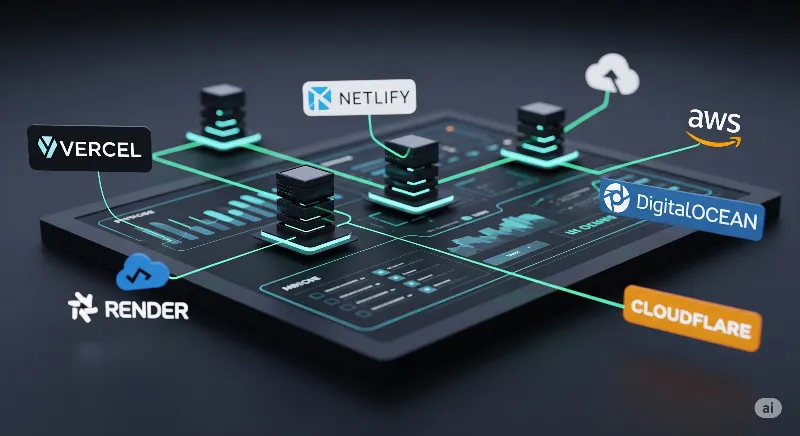
📅August 24, 2025
If you've just created a project with Next.js 15, the next big question on everyone’s mind is: where should you host it?
Hosting has always been a bittersweet decision for developers. Some platforms excel in simplicity, others shine in scalability, and a few stand out for their affordable pricing. Now with Next.js 15 introducing faster static generation, enhanced streaming, and native sitemap support, not every hosting provider has fully optimized its infrastructure for these advancements yet.
That’s why in this guide, we’ll explore the top hosting providers for Next.js 15 applications in 2025. You’ll get the pros, cons, and practical use cases, so you can confidently decide what’s best for your project—whether it’s a personal blog, SaaS application, or enterprise-level client work.
Also Learn : Best Markdown and Rich Text Editor for React/NextJs App
1. Vercel – The Official & Most Popular Choice
When developers think of Next.js hosting, Vercel is usually the first name that comes to mind. And rightly so—Vercel was built by the very creators of Next.js.
Why Vercel is Excellent for Next.js 15
Zero configuration → Simply connect your GitHub repo and deploy instantly.
Edge Functions → Outstanding for serverless computing and global content delivery.
Native Next.js 15 support → Features like streaming, the app router, and built-in SEO work seamlessly.
Free tier → Perfect for hobby projects and early-stage startups.
Where Vercel Falls Short
Pricing escalates significantly as you scale.
Offers less backend control compared to VPS solutions.
Some developers prefer greater customization of infrastructure.
💡 If you’re launching a blog, portfolio, or an initial SaaS application, Vercel is almost a no-brainer.
2. Netlify – A Reliable Alternative
Netlify is another leading hosting platform for modern applications. Originally a pioneer in the JAMstack movement, it has steadily evolved to support Next.js projects effectively.
Pros
Effortless deployments from GitHub/GitLab.
Built-in serverless functions.
Generous free plan for smaller apps.
Strong CI/CD pipelines.
Cons
Doesn’t yet fully support advanced Next.js 15 features (e.g., streaming isn’t as smooth as Vercel).
Pricing can appear affordable at first but grows with team size and bandwidth usage.
💡 Netlify is ideal if you already enjoy its workflow integrations and feel comfortable within its ecosystem.
3. Render – The Balanced Middle Ground
If Vercel feels restrictive and Netlify doesn’t inspire confidence, Render is one of the most compelling middle-ground hosting solutions in 2025.
Why Developers Like Render
Full-stack friendly → Host your frontend, backend, and database together.
Greater control → Compared to Vercel or Netlify.
Transparent flat pricing model → Easier to forecast costs.
Supports Next.js SSR and API routes with minimal friction.
Drawbacks
Smaller ecosystem compared to bigger players.
Slightly slower deployments globally, unless configured well.
💡 If you’re looking for backend flexibility while still keeping Next.js deployment straightforward, Render is an excellent choice.
4. DigitalOcean – VPS for Developers Who Want Full Control
DigitalOcean isn’t a Next.js-specific platform—it’s closer to pure infrastructure. But for many developers, its freedom and transparent pricing make it a long-time favorite.
Benefits
A $5/month droplet can easily run a Next.js 15 app using Nginx + Node.
Full stack control (databases, caching, scaling).
Great for developers who want to avoid vendor lock-in.
Challenges
Requires manual setup (Next.js, PM2, reverse proxy, SSL).
Not beginner-friendly.
Scaling demands solid DevOps skills.
💡 DigitalOcean is best suited for developers who are comfortable managing servers and want maximum flexibility at the lowest cost.
5. AWS Amplify & Other Enterprise-Grade Options
For teams or organizations requiring enterprise-level hosting, providers like AWS Amplify, Google Cloud, and Microsoft Azure are strong contenders.
Why Choose AWS/Cloud Giants
Virtually unlimited scalability.
Integration with a wide ecosystem of enterprise tools.
Robust security and compliance capabilities.
Downsides
Complex setup that can overwhelm newcomers.
Costs can spiral quickly if not carefully managed.
Overkill for small to medium-sized projects.
Quick Comparison
Hosting Provider
Ease of Use
Next.js 15 Support
Pricing
Best For
Vercel
⭐⭐⭐⭐⭐
⭐⭐⭐⭐⭐
$$
Blogs, SaaS, startups
Netlify
⭐⭐⭐⭐
⭐⭐⭐
$$
JAMstack fans
Render
⭐⭐⭐⭐
⭐⭐⭐⭐
$$
Full-stack apps
DigitalOcean
⭐⭐⭐
⭐⭐⭐⭐
$
Devs who want control
AWS Amplify
⭐⭐
⭐⭐⭐⭐
$$$
Enterprise apps
Final Thoughts
Next.js 15 hosting in 2025 has never been more streamlined. Gone are the days of spending countless hours configuring servers just to get your app online. Today, the real decision comes down to your project’s goals, your budget, and the level of scalability you require.
For SaaS MVPs and personal blogs, Vercel remains the standout choice.
For greater flexibility, Render or DigitalOcean provide more control.
For enterprise-grade reliability and integration, AWS Amplify or Google Cloud are the top-tier solutions.
The ultimate takeaway? Hosting is not one-size-fits-all. The key is to choose a platform that strikes the right balance between performance, cost-efficiency, and ease of management.